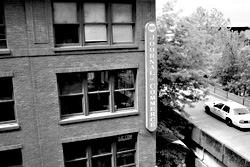Down an impossibly steep and narrow set of stairs, the type usually found in an Amsterdam canal house or leading to an especially dark and dusty attic, sits a printing press the size of a large semi truck. Around it are strewn massive spools of newsprint, like rolls of toilet paper on steroids. The ivy-covered brick building in which this apparatus resides stands on the northern edge of Pioneer Square. It belongs to the Seattle Daily Journal of Commerce, known to its readers as the DJC, a newspaper whose traditional design and editorial content appears as unchanged as this old press room.
Constancy may be the key to success for the DJC. In a world of giveaway new media, the 114-year-old paper retains a franchise that is seemingly untouched by the forces assailing every other print product in town. Yes, a typical issue of the DJC has four or so pages of brief news articles covering real estate, construction, and trade. But the remaining 20 pages are nearly all classified advertisements—a remarkable figure considering that virtually every other publication in the nation has seen its classifieds looted by Craigslist and other free online listing sites.
The key is that this isn’t standard classified fare—people selling ’85 Hondas and unused Bowflex machines. Instead, much of the DJC is dominated by what are known as public notices.
Nearly as old as American laws themselves, public notices are mandated in every state, and for the most part, are meant to do just what their name implies: notify the public of matters of legal importance. “In some cases these were the first things that newspapers ran,” says Mort Goldstrom, vice president of advertising at the Newspaper Association of America. There are literally hundreds of different types. Local governments may publish notice of an upcoming public hearing. The bank foreclosing on a property will publish an ad to notify residents (in addition to using the mail). Lawyers are required to place probate notices to alert potential creditors about the death of a person who may have unpaid bills.
“[The public-notice system] was designed years ago when newspapers were the best way to reach everybody,” says Bruce Rowe, a general-practice attorney based in Renton who specializes in real estate, wills, and probate. “But it’s not the most effective way to actually get notice in this day and age.”
Maybe not. But thanks in part to Revised Code of Washington Chapter 65.16, which outlines requirements for the aforementioned processes—and which shows no sign of being “revised” again soon—the DJC is living large. You can get 12 months of The Seattle Times for $150, but a year’s subscription to the DJC runs $220. And it’s another $210 to view the content online.
On a sleepy Friday afternoon at the DJC‘s offices, the paper’s sandy-haired publisher, Phil Brown, is dressed in a black polo and khaki slacks. He is the fourth generation of his family to take the DJC helm since his great-grandfather bought into the newspaper business just after the turn of the century. But he looks as if he would be just as comfortable on the PGA tour as in the newsroom. Brown, who started at the family business in 1984 as a reporter shortly after graduating from the University of Washington with a degree in economics, points out that public notices are not unique to the DJC.
“There’s lots of other publications all over the city, county, and state that are publishing public notices all the time,” he says. The DJC‘s advantage, he says, is “We’ve been doing it for a long time, and have provided good customer service. That’s been the way to get repeat customers.”
In fact there are 40 publications in King County alone, ranging in size from the Capitol Hill Times to The Seattle Times, that are certified by the county clerk as “legal papers,” meaning they meet the broad state criteria required to print legal notices. The most stringent requirement: A paper must contain “news of general interest.” In most states, says Goldstrom, there’s also “some quota or percentage of people in the municipality that the paper has to reach.” But Washington has no such requirement. The print edition of the DJC has a circulation of about 4,000, according to Brown.
In certain cases, such as a summons for a paternity hearing, the plaintiff in the suit may dictate which paper is used. But you need only look at the classified sections of the 39 other “legal papers” in town (including Seattle Weekly) to see that the DJC mostly dominates the public-notice market.
“It’s less expensive,” says attorney Rowe. “I don’t know of any newspaper in the state that’s as inexpensive as the DJC [to print notices in].” (Though our research into rates indicates that may not necessarily be true.)
There can be other advantages to tucking away your notice on p. 19 of the DJC. In the case of probate notices, for example, state law requires that they be published for three consecutive weeks. After that, creditors have four months to petition the deceased’s estate for payment. If they miss the deadline, those managing the estate are actually prohibited from paying.
“If they come four months and a week later, you can say, ‘You’re out of luck,'” says Rowe. Publishing a probate notice isn’t mandatory, but if the estate doesn’t do it, that window for claims expands to two years.
According to Rose Cross, a manager for Rainier Collection Service Inc. in Bellevue, published probate notices often go unnoticed. “I didn’t even know that those were listed there,” Cross says. “We have tens of thousands of accounts. There’s a whole lot of work to do. You’ll probably find that most agencies don’t [check the papers for notices.] The percentage of accounts we come across with an individual deceased, it’s not like it’s an everyday occurrence that you need to have a ton of resources to check for it every day or every week. It would be nice to have a Web site to check it against.”
Cross isn’t the only one to have wondered why probate notices haven’t gone digital.
“The Internet is still unfamiliar and new,” says Rowe. (Anyone who’s seen the stacks of documents still lugged around by attorneys knows how true that is of Rowe’s world.) “[The state] hasn’t thought through the possibility of a central posting area. It’s only been a few years that law information has been timely and consistently published on the state’s Web site. It takes time for people to come up with these ideas. To me it’s an area of potential reform that would be beneficial. It would be much more efficient to have a single clearinghouse that wouldn’t incur any publication costs for anyone and yet would provide a much more comprehensive means for creditors to find listings.”
Even Rose, whose collection agency all but disregards the notice system as it now stands, admits it would be good to have a free, online database against which agencies could cross-check their records, adding succinctly, “That would be very nice and helpful.”
Maybe for her. Brown sees it differently. “I hope it doesn’t change. I think the newspapers provide a good public service for these notices. I hope we’ll be allowed to do that in the future.”
Though Brown declines to comment on what percentage of his paper’s revenue comes from public notices, he says the DJC by no means subsists solely on state-mandated advertising. In fact, the paper is a powerhouse in the Northwest construction beat, with contractors as far away as Alaska poring over its pages looking for projects on which to bid. While government-funded construction projects require a public notice soliciting bids, the DJC‘s pages are teeming with bid requests and advertisements for private contractors as well. “Everyone uses it,” says Carrie Hansel, an estimating assistant at ACC Hurlen Construction in West Seattle. “That is the publication for construction for this area. We advertise in it, we put our bid requests in it. If people want a response, they put it in the DJC. It’s just always been that way; I don’t know why, if they captured the market niche early in life or what. But I’ve been here for six years…that’s all I’ve known.”
Though the DJC faces competition from other national construction-bid aggregators like Onvia.com and McGraw-Hill, it has remained the standard locally because of its online innovation. In addition to djc.com, the pay-for-access Web site, the paper also offers plancenter.com, which, for more than $2,000 a year, allows contractors to download and view plans for potential projects.
“It’s a pretty sophisticated system,” says Brown proudly.
When asked why the DJC charges for access to its online version, which includes public notices, Brown responds, “I would go about it the other way and ask why do so many other people give away their content for free?”







